Thanks to MSFT Group Program Manager, Oren Ryngler for this amazing session. Exciting stuff guys.
Overview

Across the traditional sales cycle there are numerous products available to help sales team be more productivity:
Here is the mapping of tools across this process flow:
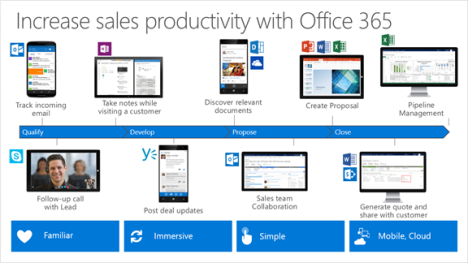
Immersive experience across applications means that contextual information from CRM is available in other applications. This is the primary focus of spring release. Here are some awesome features.
Who has Clients complaining about CRM outlook Client because it’s heavy and slow? This is for you 🙂
1. Outlook Client for CRM (Spring Release – May)
-
Folder based tracking
- Outlook folders can be configured to synchronize with CRM
- When an emails comes in user can just drag and drop in the right folder and it will show up in CRM
- Another way is to automate further is to have inbox rules that will move emails to a folder and then the emails will be tracked in CRM
-
Setting it up in CRM
- Go into Options in CRM
-
Go to Set Personal Settings
- New feature: Folder level tracking
- All the folders are available in this section from Exchange
- You can select the account to map this folder to
- New feature: Folder level tracking
- Go into Options in CRM
- Outlook folders can be configured to synchronize with CRM
-
Outlook Apps: (Spring release)
- Outlook client is heavy so MSFT is going to release outlook app for CRM
- Important: Outlook app does not have to follow release cycle for Outlook or CRM 🙂
-
You can track emails and then get info from CRM
-
Against an email you see the “Dynamics CRM application” link in outlook
-
- Outlook client is heavy so MSFT is going to release outlook app for CRM

-
If user is in CRM all the information will be available from CRM in the application
-
Scenarios like all the relative information pertaining to following:
- Communication
- Cases
- Opportunities
- Communication
- So in case someone has already reached out to the contact then one does not have to do that again.
-
-
One can hit track and it shows all the relevant entities
- 99% of the time it is a matter of one click to select the record to track it against
-
One can search if not available as well
- 99% of the time it is a matter of one click to select the record to track it against
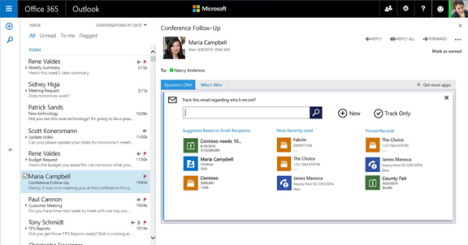
- Create Case, Opportunity, Lead or contact from the email using the “New” incase suggested records are not relevant.
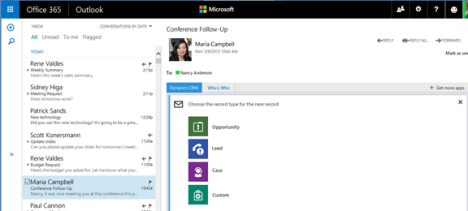
- Outlook app is built using the mobile web interface technology so all customizations can be exposed like they can be for mobile from CRM
-
All new views will be available on all different devices
- Phone, tablet and now the outlook app
- Phone, tablet and now the outlook app
-
After Spring release:
-
Enhancements:
-
Relationship intelligence:
- Who was the last person who interacted with User
- Not only pull information from CRM but also from outlook. Emails that are not tracked in CRM. I don’t know how they will make it work with mailboxes and how they will handle security but this is what was shared today.
-
Email analytics:
- Get a notification when customer opens up email
- Get a notification when customer opens up email
- Who was the last person who interacted with User
-
Integrated Compose:
- As you compose an email you can attach all the material like you do in outlook but there would be suggested material based on relevance.
- As you compose an email you can attach all the material like you do in outlook but there would be suggested material based on relevance.
-
-
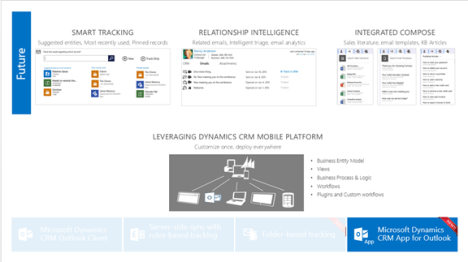
2. Integration with Microsoft OneNote (Spring Release May)
- I love OneNote and this is one product about which I can say that everyone else I know loves as well. Really excited about this feature.
-
CRM would not allow you to access OneNote just like Notes.
- Advantages of OneNote compared to existing Notes section
- Advantages of OneNote compared to existing Notes section
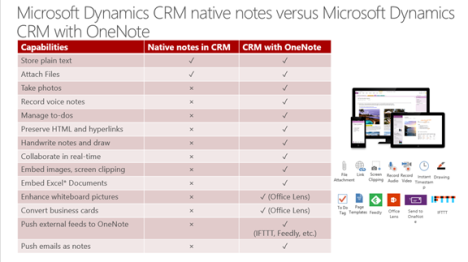
-
Experience:
- In addition to notes link one also has access OneNote section
- In windows tablet it opens it side by side
-
All the sections from OneNote notebook appear in CRM
- OneNote would allow you to add recordings
- Sound to text feature
- Pictures
-
Copy text from image and copy your info in notes:
- Business card example
- Business card example
- OneNote would allow you to add recordings
-
Each notebook relates to one entity
- Each section is a new note
- Each section is a new note
-
Setting it up:
-
Enable one note for entities in CRM
- It creates a shared one note for entity in SharePoint
- It creates a shared one note for entity in SharePoint
-
- In addition to notes link one also has access OneNote section
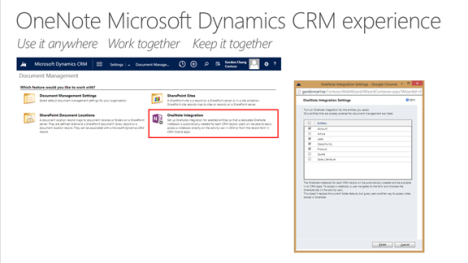
3. Immersive Excel
-
Open opportunities view
- Just like export to excel functionality there is no a button to open view in Excel
- Opens view in Excel online but it is embedded within CRM. It opens it in CRM context.
- Just like export to excel functionality there is no a button to open view in Excel
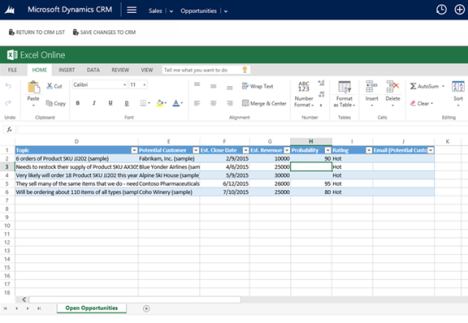
- So on your view click on open in excel and it open up within CRM so you don’t lose the context
-
Experience:
-
Do calculations:
- Play around with numbers and do your analytics
- Save it and it will be integrated in CRM directly
- So all the rows will be updated in CRM through data import. It supports up to 100, 000 rows.
- Play around with numbers and do your analytics
-
After Spring Release:
- Whenever you export to excel you will get pre-defined templates to create dashboards
-
Power BI dashboards:
- Whenever you export to excel you will get pre-defined templates to create dashboards
-
4. Collaborative selling
- Collaborate around one note
- Immersive Excel
-
Yammer:
- All the features
- All the features
-
Skype for business (announced today)
- Now lync is Skype for business
- Share screen
- Presence inside Dynamics CRM
- Now lync is Skype for business
-
Document management:
- Open your documents in CRM
- Spring release will support CRM online with SharePoint on-premises
- Open your documents in CRM
Filed under: Uncategorized | 1 Comment »


